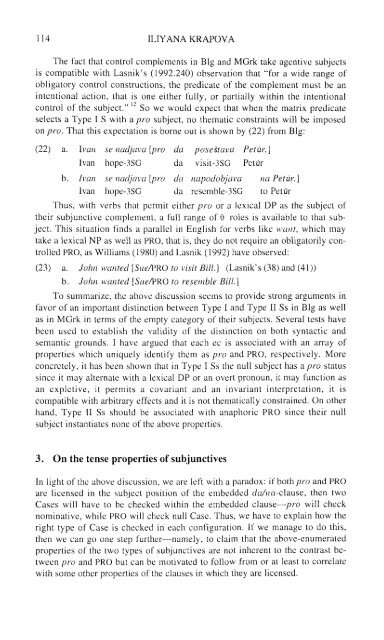Comparative Syntax of the Balkan Languages (Oxford ... - Cryptm.org
Comparative Syntax of the Balkan Languages (Oxford ... - Cryptm.org
Comparative Syntax of the Balkan Languages (Oxford ... - Cryptm.org
- No tags were found...
You also want an ePaper? Increase the reach of your titles
YUMPU automatically turns print PDFs into web optimized ePapers that Google loves.
114 ILIYANA KRAPOVAThe fact that control complements in Blg and MGrk take agentive subjectsis compatible with Lasnik's (1992.240) observation that "for a wide range <strong>of</strong>obligatory control constructions, <strong>the</strong> predicate <strong>of</strong> <strong>the</strong> complement must be anintentional action, that is one ei<strong>the</strong>r fully, or partially within <strong>the</strong> intentionalcontrol <strong>of</strong> <strong>the</strong> subject." " So we would expect that when <strong>the</strong> matrix predicateselects a Type I S with a pro subject, no <strong>the</strong>matic constraints will be imposedon pro. That this expectation is borne out is shown by (22) from Big:(22) a.b.IvanIvanIvanIvanse nadjavahope-3SGse nadjavahope-3SG[pro[prodadadadaposestavavisit-3SGnapodobjavaresemble-3SGPetur.}PeturnatoPetur. ]PeturThus, with verbs that permit ei<strong>the</strong>r pro or a lexical DP as <strong>the</strong> subject <strong>of</strong><strong>the</strong>ir subjunctive complement, a full range <strong>of</strong> 6 roles is available to that subject.This situation finds a parallel in English for verbs like want, which maytake a lexical NP as well as PRO, that is, <strong>the</strong>y do not require an obligatorily controlledPRO, as Williams (1980) and Lasnik (1992) have observed:(23) a. John wanted [Sue/PRO to visit Bill.] (Lasnik's (38) and (41))b. John wanted [Sue/PRO to resemble Bill.]To summarize, <strong>the</strong> above discussion seems to provide strong arguments infavor <strong>of</strong> an important distinction between Type I and Type II Ss in Blg as wellas in MGrk in terms <strong>of</strong> <strong>the</strong> empty category <strong>of</strong> <strong>the</strong>ir subjects. Several tests havebeen used to establish <strong>the</strong> validity <strong>of</strong> <strong>the</strong> distinction on both syntactic andsemantic grounds. I have argued that each ec is associated with an array <strong>of</strong>properties which uniquely identify <strong>the</strong>m as pro and PRO, respectively. Moreconcretely, it has been shown that in Type I Ss <strong>the</strong> null subject has a pro statussince it may alternate with a lexical DP or an overt pronoun, it may function asan expletive, it permits a covariant and an invariant interpretation, it iscompatible with arbitrary effects and it is not <strong>the</strong>matically constrained. On o<strong>the</strong>rhand, Type II Ss should be associated with anaphoric PRO since <strong>the</strong>ir nullsubject instantiates none <strong>of</strong> <strong>the</strong> above properties.3. On <strong>the</strong> tense properties <strong>of</strong> subjunctivesIn light <strong>of</strong> <strong>the</strong> above discussion, we are left with a paradox: if both pro and PROare licensed in <strong>the</strong> subject position <strong>of</strong> <strong>the</strong> embedded da/na-clause, <strong>the</strong>n twoCases will have to be checked within <strong>the</strong> embedded clause—pro will checknominative, while PRO will check null Case. Thus, we have to explain how <strong>the</strong>right type <strong>of</strong> Case is checked in each configuration. If we manage to do this,<strong>the</strong>n we can go one step fur<strong>the</strong>r—namely, to claim that <strong>the</strong> above-enumeratedproperties <strong>of</strong> <strong>the</strong> two types <strong>of</strong> subjunctives are not inherent to <strong>the</strong> contrast betweenpro and PRO but can be motivated to follow from or at least to correlatewith some o<strong>the</strong>r properties <strong>of</strong> <strong>the</strong> clauses in which <strong>the</strong>y are licensed.
















